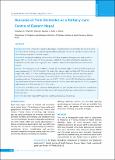Please use this identifier to cite or link to this item:
https://hdl.handle.net/20.500.14356/1715| Title: | Outcome of Twin Deliveries at a Tertiary Care Centre of Eastern Nepal |
| Authors: | Chaudhary, S Singh, R R Shah, G S Agrawal, J Kafle, S Shah, L |
| Citation: | ChaudharyS., SinghR. R., ShahG. S., AgrawalJ., KafleS., & ShahL. (2016). Outcome of Twin Deliveries at a Tertiary Care Centre of Eastern Nepal. Journal of Nepal Health Research Council, 14(2). https://doi.org/10.33314/jnhrc.v14i2.802 |
| Issue Date: | 2016 |
| Publisher: | Nepal Health Research Council |
| Article Type: | Original Article Original Article |
| Keywords: | Low birth weight (LBW) Preterm Small for gestational age (SGA) Twins |
| Series/Report no.: | May-Aug, 2016;802 |
| Abstract: | Abstract Background: Twins, compared to singletons, have higher perinatal mortality and morbidity. The aim of this study was to describe the twinning rate, epidemiological variables and hospital outcome of twin deliveries and to find out ways of better management of twins in our part. Methods: A retrospective evaluation of the outcome of 92 twin pregnancies during one year study period (1st January 2014 to 31st December 2014) was conducted at BPKIHS. Twins delivered within the institution were included but cases less than 28 weeks gestation were excluded. Maternal and neonatal data were retrieved and analysed. Results: The twinning rate was 9.2/1000 (92/10,031). The mean birth weight was 1636.30 ±339.21 grams and mean gestational age 34.31±2.67 weeks(28 – 40 weeks). One hundred eighty-two babies (98.9%) were low birth weight (LBW) while 32.1% were small for gestational age (SGA). There was mild, moderate and severe growth discordance in 63 (68.5%)22 (23.9%)and 7 (7.6%) respectively. Three (3.26%) of 92 pairs had twin-to-twin transfusion syndrome. The hospital mortality rate was 10.87% (20/184) and 69 (37.5%) babies had complications. The clinical causes of death were hyaline membrane disease in 7 (3.3%), severe birth asphyxia in 5 (2.7%), congenital malformations in 3(1.6%) and sepsis in 3 (1.6%) babies. Conclusions: Twin deliveries are common in this hospital and have poor hospital outcome with more complications and mortality. Hence there is a need for further studies with long term follow-ups to plan for better management of twins in our part. Keywords: Low birth weight (LBW);preterm; small for gestational age (SGA);twins. |
| Description: | Original Article |
| URI: | http://103.69.126.140:8080/handle/20.500.14356/1715 |
| ISSN: | Print ISSN: 1727-5482; Online ISSN: 1999-6217 |
| Appears in Collections: | Vol. 14 No. 2 Issue 33 May-Aug 2016 |
Files in This Item:
| File | Description | Size | Format | |
|---|---|---|---|---|
| 802-Article Text-1480-3-10-20170528.pdf | Fulltext Download | 159.59 kB | Adobe PDF |  View/Open |
Items in DSpace are protected by copyright, with all rights reserved, unless otherwise indicated.
